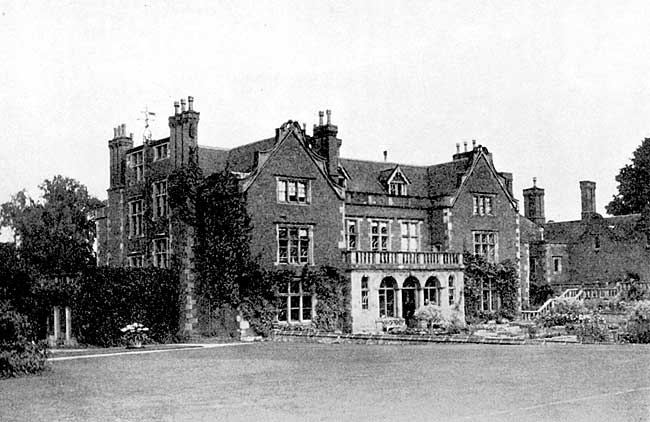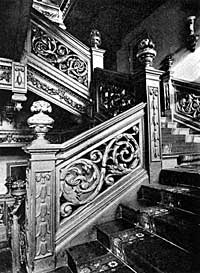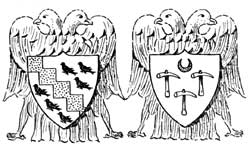The Third Summer Excursion, 1924.
ON Thursday, the 18th September—a glorious summer day, following a period of intermittent rain—upwards of eighty members and friends enjoyed a half day excursion in the alabaster district of Nottinghamshire.
At Thrumpton, by the kind invitation of the Rev. Lord Byron, an inspection of the Hall and grounds, and of the Church of St. Edmund was made. Lord and Lady Byron met the party and gave every facility for the visitation of the most interesting parts of the Hall, the reception rooms and the grand staircase.
Radcliffe-on-Soar was next visited, and after making an inspection of the ancient church of Holy Trinity and the beautiful alabaster monuments contained therein, the drive was continued through lovely scenery to Rempstone Hall, where the party was entertained to tea by the kind invitation of Mr. and Mrs. J. N. Derbyshire.
After a sojourn, all too short to do adequate justice to the gardens and grounds, and the adjacent neglected graveyard of St. Peter-in-the-rushes, the journey was continued to Gotham, where one section visited the ancient Church of St. Lawrence, while others listened to a most interesting dissertation by Mr. Derbyshire on gypsum and its commercial development, and afterwards made a tour of inspection of the mines and the workings.
The following papers were read during the visit :—
Thrumpton Hall
BY HARRY GILL, F.S. ARCH.

The south front of Thrumpton Hall.
THRUMPTON Hall stands in peaceful seclusion on the right bank of the river Trent, about seven miles above Nottingham. The mellow tones of the brickwork, the quaintly shaped curly gables, the heavy mullion windows, the glistening glass in the casements, and the internal elegance, all combine with the flower gardens and surroundings to call forth our interest and admiration.
The interest of all members of the Thoroton Society is still further enhanced by the fact that two-and-a-half centuries ago, a History of the Antiquities of Nottinghamshire was projected here. The occasion is mentioned in the Preface to that work addressed to William Dugdale, Esq., Norroy King of Arms, “written on Munday in Easter week, April 16th, Anno Dom. 1677.”
The author therein says “you will remember that some years after your Visitation of our County was completed (1662) you and I being with our friend Mr. Gervas Pigot, since deceased, at his house at Thrumpton . . . I was persuaded to write the History of this County” . . . and then he goes on to say that Morant was to do the like for Essex.
Robert Thoroton, a Doctor of Physick, was an out-and-out Royalist and a staunch Episcopalian, Dugdale adhered to the old faith, while Pigot was a Puritan, who in early life had been on the border line,— to use Mr. Hutchinson’s phrase,—but we must remember that when this interview took place, the unhappy wars had ceased and the Restoration of the Monarchy was an accomplished fact. The conference therefore was not between partisans, but between a doctor and his patient and their friend; the pretty play of words about the glory of writing a book being on a par with the profit derived by curing a man’s body, with which the Doctor yielded to the entreaty, is thus made understandable.
During the troublous days in the earlier part of the 17th century, stirring episodes of tragic and bitter strife between friend and friend had taken place in this vicinity. Some of them will be mentioned later, but they will interest or not according to whichever way your politics incline your thoughts.
The earliest historical record we have is that one part of this manor of Thrumpton was in the possession of the great Roger de Bush. His tenants, the Powdrells, had their seat here without interruption for centuries, until they became involved in Gunpowder Plot of 1605. In the older part of their house, on the western side of it, where a new staircase was subsequently erected, there was a priest’s hole, with a secret staircase in the dummy chimney breast.
Tradition is persistent that Garnet, the Provincial of the English Jesuits, and author of the Plot, was in hiding here. There is no foundation for the tradition, for Henry Garnet, who was the son of Brian Garnet, the Master of Nottingham Free Grammar School, was discovered in a hiding hole in Hindlip Castle, near Worcester, the seat of the Abingdons, and executed in St. Paul’s Churchyard, 3rd May, 1606.
At the trial the Powdrells were accused of complicity in the Plot, attainted, and their estates escheated. Gervas Pigot, of Weston-on-Trent, not far from this place, acquired most of this lordship by purchase in 1608.
Gervas was a descendant of the ancient family of Priott or Pigot (also written Picot, Pikot) who, as far back as the reign of King John, held the towns of Kingston and Radclive-on-Sore; and to him King James I. had recently granted the Rectory of Radcliffe-on-Soar, and the chapelry of Thrumpton. Gervas died in 1617 and was succeeded by his son Gervas, who inclosed the lands, enlarged the house, and greatly improved the estate. By his marriage with Maria, the eldest of the three daughters and co-heiresses of St. Andrew of Gotham, he greatly enlarged his lands and possessions.
Looked at from this distance of time the life story of the second Sir Gervas seems paradoxical. Thoroton tells us on the one hand, that he was a religious, serious, wise gentleman, true-hearted to God and his country; and on the other hand the same authority says that he squandered his own fortune, as well as his wife’s in extravagant living. Fortunate it was for him that he served his country in counsel rather in action, and thereby saved himself from the fate which overtook some of his earlier associates. It is characteristic of him that upon being served with a summons from the Sheriff (Col. John Hutchinson) to attend Parliament in 1659—the year after the Protector died—he sent a diplomatic excuse to the effect that he had been of late in some distemper of his health, but resolves with all speed, if God enable him, to give his attendance. This letter is still extant. Gervas Pigot sat in the Commonwealth Parliament, as Member for Nottingham, by the order of Lord Protector Cromwell.

Jacobean staircase at Thrumpton Hall.
Notwithstanding his infirmity, and despite the troublous times in which he lived, he spent money and thought on the enlargement of his house. There was, and still is, a good plain Jacobean staircase in the eastern wing, but he was not content with this, and so fell a victim to a prevailing fashion. The Lord Protector Cromwell, only a few years before he died, had bought a house on Highgate Hill for his son-in-law, General Henry Ireton. To this house he had added a newel staircase, working in a space 16ft. square. The newel tops were sculptured in illustration of types of soldiers in the model army, and emblems of war were carved in the balustrade.
Gervas Pigot, being one of the clique, needs must do something similar. He accordingly caused a new staircase to be set up in his house at Thrumpton, from basement to attic, in one continuous open flight, after a model much in vogue at the Restoration. Neither the name of the designer, nor the date of execution is anywhere recorded, but the work bears sufficient evidence to show that the date may be allocated to circa 1660, and the design to John Webb.
The heraldry determines the date for us; for in like manner as Ireton displayed upon his staircase the distinction which had come to him by war, so Pigot displayed the distinction which had come to him by ancestry. Alternate shields of Arms, carried on the breast of conventionalized double-headed eagles in the filling of the balustrade give us the clue:—
 |
The first shield represents the arms of the ancient family of Pigot—AZURE a bend lozengee OR deeply indented, between six martlets OR
The second the arms borne by Gervas Pigot’s family in later years three pickaxes, ARGENT, a mullet for difference OR.
Crest, A greyhound couchant SABLE collared ARGENT, the collar garnished OR.
When William Dugdale, Norry King of Arms, had finished his visitation of the County (1662), he stayed for a few days at Thrumpton, as before narrated, with his friend Pigot, when “he judged the said Sir Gervas Pigot to be descended from a branch of the Pigots of Radclyffe in this Parish.” He therefore granted him and his descendants to bear the golden martlets of old Sir Peter Pigot, instead of the silver pickaxes borne by Sir Gervas Pigot, his father. I think the fact that both coats of arms are displayed on the staircase indicates that it was erected just when the heraldic change was being made. The eagles with two necks have no heraldic significance; but it is not without interest to note that at Thorpe Hall, eagles are carved on the gate, piers, etc., but there they represent the crest of St. John. At Thrumpton they are merely copies without any regard, save that they may help to identify the designer. It is known that in 1656 John Webb was engaged in building Thorpe Hall, about three miles from Peterboro’, for Oliver St. John, the younger,—at one time the Lord Chief Justice of England, and considered to be the leading man in the Parliamentary party, next after Cromwell, to whom he was related by marriage. The staircase at Thrumpton bears so close a resemblance to the work at Thorpe Hall, as to leave little doubt that the same hand designed both. John Webb was nephew, son-in-law, pupil and eventually successor to Inigo Jones one of the leading architects of his day.
The woodwork of the staircase has unfortunately been painted more than once in days gone by, whereby the grain of the wood has become obscured. An inspection of a dismantled portion from the basement flight shews that Oak (quercus robur) was used for the newels, etc., Elm (ulmus campestris) for the carved balustrade, and Pine (pinus sylvestris) for the treads and risers; probably all the timber was grown on the estate.
The style of the oak room adjoining, with its bay-wreath frieze and oakleaf ornaments, came into vogue after the Restoration in commemoration of the Boscobel oak incident of 1651. The Adams ceiling in the Saloon, and the alabaster work in the firefronts are later additions. The original painting of the poet Byron, by Philips, occupies a place of honour in the saloon, and a painting of the Lord Protector Cromwell is in the Hall. The fine collection of period furniture in the various rooms evoked a considerable amount of interest and attention.
It is a strange commentary on the times that while Sir Gervas was occupied with the work of enlarging and improving his house, some of his Puritan friends were in strangely different circumstances. In former days Sir Gervas had enjoyed a large share in the esteem of Col. John Hutchinson, who languished in prison for eleven months and died 11th September, 1664; also of Col. Henry Ireton,” the great instrument in the unhappy war,” who had died on active service at Limerick in 1657, and whose bones, along with those of Oliver Cromwell, and President Bradshaw, were exhumed and hung at Tyburn in 1660. That same year, Francis Hacker was executed at Tyburn, Gilbert Millington languished in an unknown prison, and Major General Edward Whalley had fled the country.
Amid these sad happenings it was the fortune of Sir Gervas to be made High Sheriff of the County, in 1669. Dr. Thoroton said of him at this time, his sobriety, ingenuity, generosity, piety and other virtues, few of his rank will ever exceed, if any equal.
Shortly after the Summer Assize of 1669, he died and was laid to rest in the church of St. Edmund, Thrumpton. A mural monument in local alabaster was set upon the north wall of the chancel, containing a turgid Latin inscription, said to have been composed in anticipation by Norroy King of Arms, at the visit before referred to. When the chancel was rebuilt by George Edmund Street, in 1872, the monument was removed to the south wall of the Early English tower. The church is small and exceedingly narrow, comprising tower, nave and chancel without aisle. It is but dimly lighted, so that the monument cannot be seen to advantage. An illustration of it will be found in the pages of Thoroton’s History.
Gervas Pigot’s family was left in impoverished circumstances after his death. In 1696 the Thrumpton estate was sold to a stranger to this district, John Emmerton of London. In the absence of heirs male he was succeeded by his wife’s nephew, who changed his name from Wescomb to Emmerton. He, in turn, was succeeded by his nephew, who retained both names being known as Emmerton-Wescomb; when he died in 1835, heirs male had again ceased and the inheritance was divided between three nieces, the eldest of whom took the Thrumpton estates, and in 1843 married George Anson, the 8th Lord Byron, who was the son of George Anson, the 7th Lord Byron, who was descended from the poet’s first cousin, Admiral Byron; and thus the connection between Thrumpton and the Byrons of Newstead began.
The second of the three nieces inherited the Essex estates, and married the younger brother of the 8th Lord Byron, the Hon. Frederick Byron. Their eldest son, George Frederick William, succeeded his uncle as 9th Baron; and their second son, the Rev. Frederick Ernest Charles Byron, the present owner, succeeded as 10th Baron to the title and all the Wescomb-Emmerton estates.
